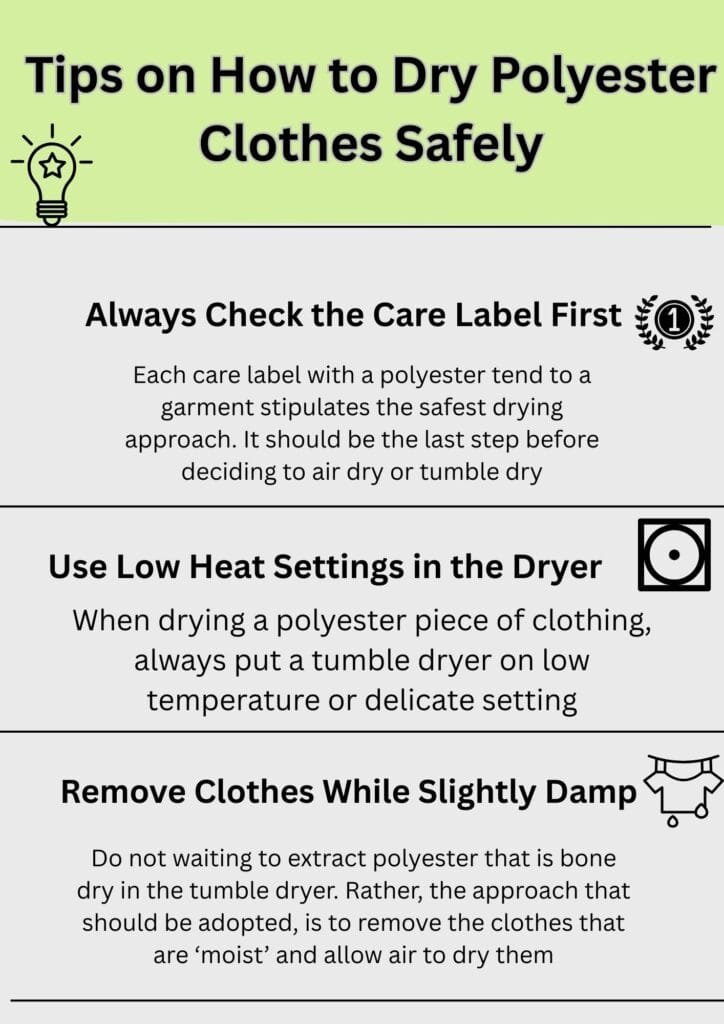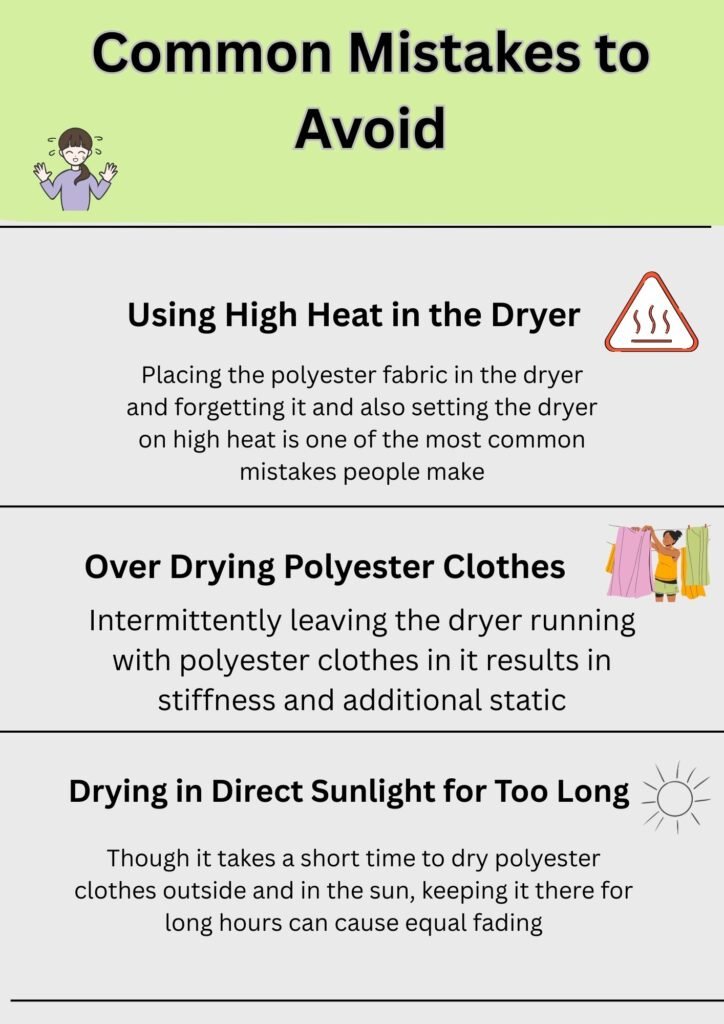Introduction
Today, one of the most popular fabrics used in clothes and home textile is polyester. Its popularity is due to the fact that it is weighless, easy to dry, wrinkle free and very durable. Polyester, despite being tough, needs extra care. Drying polyester carelessly can damage the weave, reduce the lifespan and increase the rate of wear and tear.
One of the major issues comes from the use of heat. Increased temperature on heat sensitive polyester can cause the fibers to either melt or harden. Over drying can also cause stiffness and static, while careless hanging can also stretch out the shape of the garment. Most people confuse polyester for cotton and apply the same rules of drying cotton, leading to shrunk, wrinkled or even fabric burned clothes.
This is the reason why it is useful to know how to dry polyester correctly, so that you can avoid common mistakes.
Can You Put Polyester in the Dryer?
As long as care is taken, polyester can go in the dryer. You can safely tumble dry the fabric, as long as it is on low heat. Treat the garment on a delicate, permanent press, or low temperature setting to avoid fabric damage, static and wrinkling.
Using high temperatures is the other highest danger. Since polyester is plastic, too much high temperature will certainly melt or warp the material. This will cause shine, stiffness or fabric blended with other permanently shrunk fabrics. If in doubt, it is best to start at the lowest level of temperature, retaining the damp clothes.
Learning correct settings for the dryer is the first step to learning how to dry polyester without ruining it.
Best Way to Air Dry Polyester
For most people, air drying is the safest technique for polyester garments. Polyester dries much quicker than cotton, so feel free to hang it indoors or outdoors.
While drying indoors, use a drying rack in a room with enough ventilation. Spread clothes and allow for air. Outdoors, hang polyester garments on a clothes line, protected from the strong sun, as it can fade the colors.
Air drying actively reduces the risk of high static charge accumulated, preserves the shape of the fabric and the clothes. Always avoid high tension hangers or clothespins that give a permanent shape to the clothes. If air drying is the most gentle and eco friendly method, it is also an answer to how to dry polyester.
How to Tumble Dry Polyester Safely
It is fine to tumble dry polyester when needed, as long as safe methods are followed. Always pick the lowest temperature possible. Because polyester dries quickly, it doesn’t need long drying cycles. For the majority of lightweight polyester items, 20 to 30 minutes is adequate.
To reduce static buildup, throw in some dryer balls, or better yet, a damp, clean cloth. The steam helps to relax the fibers, thereby preventing the polyester from clinging to itself. Do not dry large loads of polyester items at once, as a result of bunching, polyester may be the cause of unevenly dried items, or excessive wrinkles.
To dry polyester in a dryer safely, the dryer must first be set to a short drying cycle, followed by low temperature, and must be set to un-tumble so the clothes can be taken out promptly. Keeping to this routine is a guarantee that the clothes won’t be over dried, or the materials will be damaged.
How to Dry Polyester Without Shrinking
When it comes to the fabrics that are blended, like poly-cotton or poly-rayon, variations are more susceptible to changing sizes when exposed to oxygen under heat.
Remember to use low and cool settings when drying the materials, or opt to air dry. Keeping polyester exposed to a dryer on high settings is a big no, as this will cause the blended materials to shrink. For more precaution, take the items out of the dryer when they are slightly damp, air dry them, and they will dry to the perfect softness.
Understanding how to dry polyester without shrinking is simple, you just need to control the amount of heat that is used and the garments will last longer.
Tips on How to Dry Polyester Clothes Safely

Always Check the Care Label First
Each care label with a polyester tend to a garment stipulates the safest drying approach. It should be the last step before deciding to air dry or tumble dry. The label cautions you to prevent possible damage and outlines instructions.
Use Low Heat Settings in the Dryer
When drying a polyester piece of clothing, always put a tumble dryer on low temperature or delicate setting. If the temperature is to high, the nylon can be melted, stiff and cause the garment to be highly damaged. It’s wise to keep the temperature low on the required polyester setting.
Remove Clothes While Slightly Damp
Do not waiting to extract polyester that is bone dry in the tumble dryer. Rather, the approach that should be adopted, is to remove the clothes that are ‘moist’ and allow air to dry them. This method will work well in due to the always dry method that will touch the surface of the garment.
How to Remove Wrinkles from Polyester After Drying
Polyester is known for being wrinkle resistant, however, after drying, some creases may remain. The good news is that removing these creases is simple.
The best way is to steam the fabric, which is safe, effective, and the most gentle method. Steam will relax the fibers of the polyester without the risk of melting. If you decide to iron, always set the iron to the lowest synthetic setting, and place a piece of cotton fabric between the iron and the fabric. The cotton barrier will prevent the shine marks and damage the fabric may receive from the iron.
Another tip to easily remove the creases is the trick of the dryer. Put the wrinkled polyester piece into the dryer along with a damp towel and dry for about 10 minutes. The towel will create steam, helping to smooth the polyester.
Every technique mentioned is important for someone who is a beginner and is trying to learn how to dry polyester.
How Long Does Polyester Take to Dry?
Polyester dries faster than most natural fabrics because it absorbs less moisture. On average, polyester drying times are:
- 20–30 minutes in a dryer on low heat
- 1–3 hours indoors on a rack depending on airflow
- 30–60 minutes outdoors in warm, breezy weather
Daily polyester wear will be more comfortable, as the faster the garment dries, the more convenient it is. Knowing the the average time it takes a polyester fabric to dry can assist you in developing drying plans.
Drying Polyester Blends (Poly-Cotton, Poly-Spandex, etc.)
Not all polyester fabrics are the same. Blends require special care since they combine polyester with other fibers.
- Poly-Cotton Blends: These may shrink under high heat, so stick to low heat or air drying.
- Poly-Spandex Blends: Spandex is very heat-sensitive, so always air dry or use the lowest dryer setting.
- Poly-Wool and Poly-Rayon Blends: These blends are delicate, so air drying is the safest choice.
The key rule to drying polyester blends is to dry them more gently than pure polyester. Always check care tags first, and avoid drying with unnecessary heat.
Common Mistakes to Avoid
Drying polyester may look simple, but small mistakes can cause long-term damage to your clothes. Avoiding these errors is essential if you want your polyester garments to last longer and stay wrinkle-free. Below are the most common mistakes people make when learning how to dry polyester and why you should avoid them.

Using High Heat in the Dryer
Placing the polyester fabric in the dryer and forgetting it and also setting the dryer on high heat is one of the most common mistakes people make. High temperatures of the dryer can melt polyester and heat sensitive fibers and also burn and shine the apparel it is possible polyester can also be warped or burned. The appliance “Dryer” in low or easy settings fabric or dryer set on delicate settings is the best option so the fabric can be protected.
Over Drying Polyester Clothes
Intermittently leaving the dryer running with polyester clothes in it results in stiffness and additional static. Polyesters also attracts dust and lints the most. Be dry the clothes as soon as they completely dry so long cycles are stubbornly avoided.
Drying in Direct Sunlight for Too Long
Though it takes a short time to dry polyester clothes outside and in the sun, keeping it there for long hours can cause equal fading. Sunrays can weaken the fabric dyes and it is worse for bright colored clothes. Shade drying is best and helps the fabric or polyester to keep vibrance and color.
Leaving Clothes in the Dryer After the Cycle
Deep stubborn and hard to remove wrinkles can be achieved from forgetting the polyester garments before taking them out of the dryer. It is important to keep them in dryer so they don’t get fine creases and also take out the clothes after.
Conclusion
Drying polyester hardly needs to be complicated. The best options are low-heat tumble drying or air drying. Air drying is free, eco-friendly, and does not create static. It is best for the protection of the fibers. Tumble drying is handy, but the lowest settings and short cycles are a must.
If any wrinkles form, damp towels and steam in the dryer can be useful. For blends, treat them more cautiously and avoid high heat. Above all, always consult the care label of the fabric before deciding on a drying method.
If you master drying polyester, you won’t have to worry. Your clothes will feel soft, smooth, and still stylish for years.
FAQs
Can polyester shrink in the dryer?
If on high heat, blends do shrink, but pure polyester rarely does.
Can you dry polyester in the sun?
Yes, but avoid long sun exposure as the UV rays can fade bright colors.
Why does polyester get static after drying?
Static is a result of the fabric being overly dried and generating friction. Use dryer balls or a damp cloth to mitigate it.
Can soccer jackets, pillows, or shoes be dryed?
Indeed, but for safety’s sake, air-drying is best. If machine-drying is unavoidable, only use low heat.



